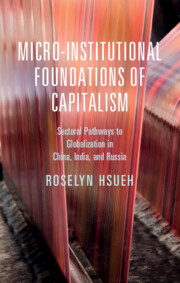Book contents
- Micro-institutional Foundations of Capitalism
- Micro-institutional Foundations of Capitalism
- Copyright page
- Dedication
- Contents
- Figures
- Tables
- Acknowledgments
- Part I Politics of Market Governance
- 1 Understanding Varieties of Market Governance in the Age of Globalization
- 2 Perceived Strategic Value and Sectoral Structures and Organization of Institutions
- Part II Nations and Sectors: Patterns of Market Governance
- Part III National Configurations of Sectoral Models
- Bibliography
- Index
1 - Understanding Varieties of Market Governance in the Age of Globalization
from Part I - Politics of Market Governance
Published online by Cambridge University Press: 16 June 2022
- Micro-institutional Foundations of Capitalism
- Micro-institutional Foundations of Capitalism
- Copyright page
- Dedication
- Contents
- Figures
- Tables
- Acknowledgments
- Part I Politics of Market Governance
- 1 Understanding Varieties of Market Governance in the Age of Globalization
- 2 Perceived Strategic Value and Sectoral Structures and Organization of Institutions
- Part II Nations and Sectors: Patterns of Market Governance
- Part III National Configurations of Sectoral Models
- Bibliography
- Index
Summary
Beyond macroeconomic indicators and simple observations that China, India, and Russia are large and diverse developing countries shedding socialist economies, what is often overlooked is that these countries’ development trajectories are nationally distinct and sectorally variegated. The commonality of market liberalization in the context of their global economic integration has translated into very different pathways to development, revealing stark differences in micro-institutional foundations, which vary by sector. This book unravels the puzzles with three overarching claims. First, mediating the impacts of globalization and economic liberalization on industrialization are dominant nation-specific sectoral patterns of market governance. Market governance structures comprise two dimensions (level and scope of the state in market coordination and dominant distribution of property rights arrangements). The conceptualization recognizes the various state authorities and market actors in coordination mechanisms and broadens measures of institutional quality beyond de jure private property rights and credible commitment. Second, the values and identities of national political economic elites as they respond to objective political and economic pressures internal and external in nature interact with sectoral structures and organization of institutions. The resultant national configurations of sectoral models, the third claim of the book, negotiate global economic integration with impacts on actual development outcomes.
Keywords
- Type
- Chapter
- Information
- Micro-institutional Foundations of Capitalism , pp. 3 - 30Publisher: Cambridge University PressPrint publication year: 2022

